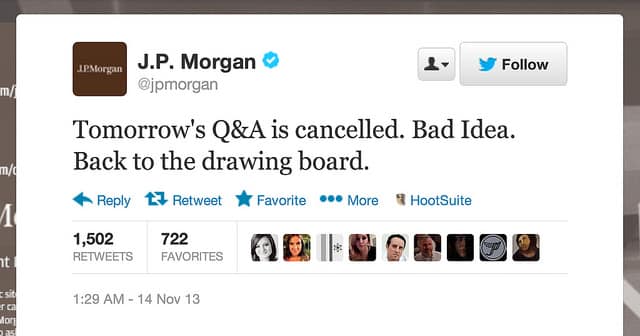
The financial services industry has never been known for leading the way in cutting edge marketing. And there are a number of good reasons for this: legislation, regulation, privacy concerns and the daunting task of communicating to broad and complex audiences. It’s no wonder finance brands are risk averse!
Social media, in particular, presents a number of challenges for those eager to capitalise on its potential to reach new customers and build brand engagement. However, with half the population identifying themselves as active social media users[1], ‘opting out’ of a meaningful social media presence is no longer a realistic option, even for finance brands. So what should you consider when getting a financial services brand set to enter the fray of social media?
Slow and steady wins nothing – this is the rub
Social media is defined by its immediacy and up-to-the-minute relevance, demanding 24-hour monitoring and the ability to respond on the fly. Yep, it’s a compliance team’s nightmare.
Financial brands have often been hampered by internal red tape, strict guidelines on what can and cannot be said, and long delays in getting a reply approved by multiple stakeholders. On a platform where responsiveness is prized, this approach can limit the opportunity for real-time engagement and delay responses until a conversation has gone stale.
How can risk-averse finance companies overcome this? Robust internal processes can help to enhance responsiveness[2], according to PwC, whose suggestions include:
- A defined governance structure for all social media platforms
- Fostering a partnership approach between compliance and marketing
- Creating clear social media policies to educate employees on how to respond safely as well as quickly
When it’s good, it’s very, very good…
Even with these processes in place, companies need to carefully consider how best to use social media as part of their marketing strategy. Not every firm will have the resources to run a 200-strong social media team, or establish its own brand publishing house, so your social media strategy should match your ability to maintain and resource it.
Done properly, social media can work very well for finance brands. Here are some things to aim for:
Listening – It may seem obvious, but a powerful benefit of social media is the opportunity to know what your customers REALLY think of you. Brands who see social media as another outlet for talking loudly about themselves miss the point. And of course, it’s critically important that after listening to your customers, you make sure you do something about their feedback (and be seen to be doing it).
Responsiveness – Following on from the point above, it’s important that you’re able to respond quickly and appropriately when something happens, either in terms of addressing a complaint as it occurs or seizing a marketing opportunity as it arises. My favourite example, although admittedly non-finance related, is Oreo’s spectacularly poised response to the Super Bowl power outage in 2013.
Authenticity – We all know the internet is awash with cynicism, and you can multiply that by ten as soon as you dip a toe into Twitter. This is why it’s critical that a brand’s social media activity genuinely reflects its values and does not indulge in flagrant self-promotion, because your audience will sniff it out from a mile away and call you out publicly for it. A prime example of this was Mastercard’s sponsorship of the Brit awards in 2014, which ended with journalists sharing the unreasonable conditions imposed in exchange for access to the awards. Ouch!
And if something goes wrong (because sometimes it will), and a message or post inadvertently offends or misses the mark, don’t waste time making excuses and shifting blame. Bite the bullet, apologise with sincerity and move on.
Personal touch – A goal of your social media strategy should be to start real conversations with your customers, so making it clear that there’s an actual person waiting to deal with any queries is a nice, reassuring way to encourage customer interaction. HSBC’s account @HSBC_UK_Help starts each day with a team member introducing themselves and inviting queries.
Speed – Harnessing the speed and reach of social media can be particularly effective when dealing with a serious issue, and a solid social media strategy should consider how it can be used as part of a firm’s crisis management response. If the fit has hit the shan and your phone lines are running off the hook, social media might be the only way you can get an essential message out to your network.
But when it’s bad it’s diabolical
Of course, no blog about social media would be complete without an example of just how horribly things can go wrong when a social media campaign does not go to plan. The winner of this category in the finance industry has to be American investment bank JPMorgan, which was forced to cancel a planned Twitter Q&A session after the hashtag was hijacked by thousands of Twitter users questioning the bank’s ethics. Here are some of my favourite responses to the #AskJPM hashtag:
- Does the sleaze wash off with a regular shower, or do you have to use something special like babies tears? #AskJPM
- I have Mortgage Fraud, Market Manipulation, Credit Card Abuse, Libor Rigging and Predatory Lending. Am I diversified? #AskJPM
- When Jamie Dimon eats babies are they served rare? I understand anything above medium-rare is considered gauche. #AskJPM
- What’s it like working with Mexican drug cartels? Do they tip? #AskJPM
- Can I have my house back? #AskJPM
The only thing that JPMorgan got right about this misadventure was knowing when to pull the pin.

As an internet commentator observed, the lesson to learn here is “if you want to get treated nicely online, don’t behave badly in the real world.” Other sensible advice is to always consider the worst-case perspective when planning a social media campaign – tread carefully when using humour, as jokes can be badly misinterpreted, and don’t hijack unrelated events for the benefit of your brand, it looks tacky.
Social media is here to stay so we’d best get good at it
The JPMorgan example highlights the terrifying thing about social media, you have no control of what people say about you. However, this is not an excuse the stay above the fray, because even if you’re not talking about your brand on social media, you can be sure other people will be.
In fact, disgruntled customers often air their grievances in social media comments. This is unavoidable and you should be prepared to tackle any complaints swiftly and try to help if possible. An exchange on TSB’s twitter feed about its morning with Peter Andre this week did make me giggle, but you can’t fault TSB’s prompt and attentive responses.
The opportunities presented by social media are clear, and as the number of platforms and users grow, financial services institutions, at a bare minimum need to be sure they’re moving with the times and speaking to their customers on their level. To truly get ahead of the game though, brands should be looking at social media as more than just a communications and marketing platform and start looking for opportunities to deliver services in new and innovative ways.
[1] https://www.slideshare.net/wearesocialsg/digital-in-2017-global-overview
[2] http://pwc.blogs.com/fsrr/2016/11/social-media-and-financial-services-time-to-innovate.html
